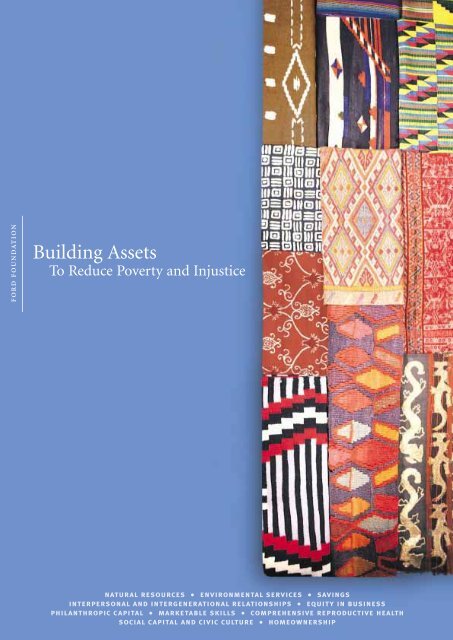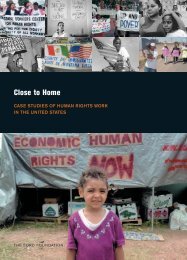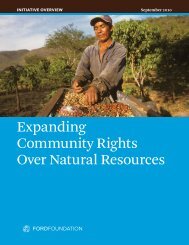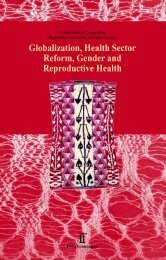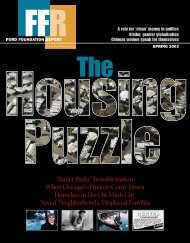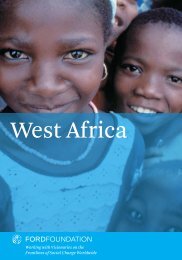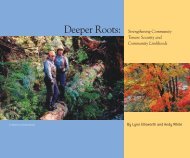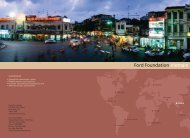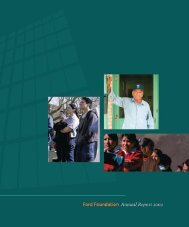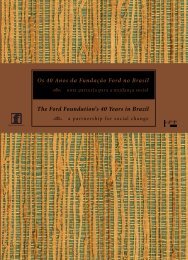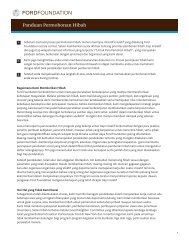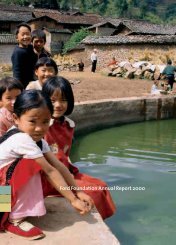Building Assets to Reduce Poverty and Injustice - Ford Foundation
Building Assets to Reduce Poverty and Injustice - Ford Foundation
Building Assets to Reduce Poverty and Injustice - Ford Foundation
- No tags were found...
Create successful ePaper yourself
Turn your PDF publications into a flip-book with our unique Google optimized e-Paper software.
FORD FOUNDATION<strong>Building</strong> <strong>Assets</strong>To <strong>Reduce</strong> <strong>Poverty</strong> <strong>and</strong> <strong>Injustice</strong>natural resources • environmental services • savingsinterpersonal <strong>and</strong> intergenerational relationships • equity in businessphilanthropic capital • marketable skills • comprehensive reproductive healthsocial capital <strong>and</strong> civic culture • homeownership
FORD FOUNDATION MISSION STATEMENTThe <strong>Ford</strong> <strong>Foundation</strong> is a resource for innovative people <strong>and</strong> institutions worldwide.Our goals are <strong>to</strong>:Strengthen democratic values,<strong>Reduce</strong> poverty <strong>and</strong> injustice,Promote international cooperation, <strong>and</strong>Advance human achievement.This has been our purpose for more than half a century.A fundamental challenge facing every society is <strong>to</strong> create political, economic <strong>and</strong> social systems thatpromote peace, human welfare <strong>and</strong> the sustainability of the environment on which life depends. Webelieve that the best way <strong>to</strong> meet this challenge is <strong>to</strong> encourage initiativesby those living <strong>and</strong> working closest <strong>to</strong> where problems are located; <strong>to</strong> promote collaboration amongthe nonprofit, government <strong>and</strong> business sec<strong>to</strong>rs, <strong>and</strong> <strong>to</strong> ensure participation by men<strong>and</strong> women from diverse communities <strong>and</strong> at all levels of society. In our experience,such activities help build common underst<strong>and</strong>ing, enhance excellence,enable people <strong>to</strong> improve their lives <strong>and</strong> reinforce commitment <strong>to</strong> society.
IntroductionSeveral years ago, the <strong>Ford</strong> <strong>Foundation</strong> under<strong>to</strong>ok a new direction in grantmakingaimed at reducing poverty <strong>and</strong> injustice around the world. The <strong>Foundation</strong>reviewed its previous efforts, along with the work of other foundations, governmentagencies, <strong>and</strong> nonprofit organizations. We consulted hundreds of individuals <strong>and</strong>organizations in the international community <strong>and</strong> also drew inspiration <strong>and</strong> ideasfrom the <strong>Foundation</strong>’s other two programs: Peace <strong>and</strong> Social Justice; <strong>and</strong>Education, Media, Arts <strong>and</strong> Culture. Out of this process of inquiry <strong>and</strong> collaboration,the Asset <strong>Building</strong> <strong>and</strong> Community Development Program began <strong>to</strong> explore whatwe call an “asset building approach” <strong>to</strong> guide our Program’s global grantmaking.This publication has been developed <strong>to</strong> serve three purposes. First, we want <strong>to</strong>introduce the basic ideas that form the framework for our grantmaking. Second,we wish <strong>to</strong> demonstrate some ways in which asset building is making a differencein diverse contexts around the world. Finally, we’d like <strong>to</strong> share some of the lessonswe have learned in using this approach.This publication is a step <strong>to</strong>ward increasing the visibility of international assetbuilding endeavors supported by the <strong>Ford</strong> <strong>Foundation</strong>, <strong>and</strong> making informationabout them accessible <strong>to</strong> a wide range of interested people. We hope that the informationcontained here will contribute <strong>to</strong> an increased underst<strong>and</strong>ing of emergingstrategies for tackling poverty <strong>and</strong> injustice around the world. At the same time, wewant <strong>to</strong> help promote new alliances <strong>and</strong> opportunities that support the evolution<strong>and</strong> impact of asset building in Africa, Asia, Latin America, <strong>and</strong> the United States.At the end of this piece, you will find a list of reference materials that contribute <strong>to</strong>the ongoing dialogue about reducing poverty <strong>and</strong> injustice worldwide.In the spirit of inquiry <strong>and</strong> collaboration we share this information <strong>and</strong> invite you<strong>to</strong> join us in this effort. Your ideas <strong>and</strong> experiences can only strengthen all ourefforts <strong>to</strong> reduce the poverty <strong>and</strong> injustice that persist in the world <strong>to</strong>day.Melvin L. OliverVice President, Asset <strong>Building</strong> <strong>and</strong> Community Development Program<strong>Ford</strong> <strong>Foundation</strong>
An Asset <strong>Building</strong> ApproachTo empower people <strong>and</strong> strengthen their political voice,we need <strong>to</strong> help them gain access <strong>to</strong> the sources of powerin any society. Typically those include assets such as skillsthat are marketable, economic resources, <strong>and</strong> social supports.This is essential if we are <strong>to</strong> make a difference.Geeta Rao Gupta iThe question of how <strong>to</strong>escape from poverty is,in essence, the questionof how <strong>to</strong> save <strong>and</strong>accumulate assets.MICHAEL SHERRADEN, ET AL.SAVINGS AND ASSETACCUMULATION IN INDIVIDUALDEVELOPMENT ACCOUNTSMost people are familiar with the concept of an asset <strong>and</strong> typically think first offinancial assets such as savings, s<strong>to</strong>cks, or property. This “balance sheet” applicationof the asset concept is important <strong>and</strong> relevant for poverty reduction. However, the<strong>Ford</strong> <strong>Foundation</strong> takes a more comprehensive view of assets, what they are, <strong>and</strong>how they can be mobilized <strong>to</strong> reduce poverty <strong>and</strong> injustice. We see assets as a broadarray of resources that enable people <strong>and</strong> communities <strong>to</strong> exert control over theirlives <strong>and</strong> <strong>to</strong> participate in their societies in meaningful <strong>and</strong> effective ways.The Asset <strong>Building</strong> <strong>and</strong> Community Development Program supports grantees inbuilding the enduring resources—assets—that individuals, organizations, or communitiescan acquire, develop, improve, or transfer across generations. These include:• Financial holdings of low-income people, such as savings, homeownership, <strong>and</strong>equity in a business; <strong>and</strong> philanthropic capital, which is composed of financialresources that are assembled in permanent endowments from <strong>and</strong> for poorcommunities.• Natural resources, such as forests, wildlife, l<strong>and</strong>, <strong>and</strong> lives<strong>to</strong>ck that can providecommunities with sustainable livelihoods <strong>and</strong> that are often of significantcultural value; <strong>and</strong> environmental services, such as a forest’s role in the cleansing,recycling <strong>and</strong> renewal of the air <strong>and</strong> water that sustain human life.• Social bonds <strong>and</strong> community relations that comprise the social capital <strong>and</strong> civicculture of a place that can break down the isolation of the poor, as well as the
Removal or reductionof poverty must bea continuous processof asset creation,so that the asset baseof a poor family becomesstronger at each economiccycle, enabling them<strong>to</strong> earn, invest, <strong>and</strong> savemore <strong>and</strong> more.A poor person cannotensure a larger share ofreturn for their workbecause their initialeconomic base ispaper-thin. Only when onecan gradually build upan asset base can onecomm<strong>and</strong> a better sharewebs of interpersonal <strong>and</strong> intergenerational relationships that individuals needas a base of security <strong>and</strong> support.• Human assets such as the marketable skills that allow low-income people <strong>to</strong>obtain <strong>and</strong> retain employment that pays living wages; <strong>and</strong> comprehensive reproductivehealth, which affects people’s capacity <strong>to</strong> work, overcome poverty, <strong>and</strong>lead satisfying lives.During the last few years, the <strong>Foundation</strong> has made grants <strong>to</strong> help build assets inAfrica, Asia, Latin America, <strong>and</strong> the United States. Our approach is very much awork-in-progress, <strong>and</strong> the assets discussed here do not represent categories thatare exhaustive. Rather, our current emphasis reflects a review of the <strong>Foundation</strong>’sprevious work <strong>to</strong> reduce poverty <strong>and</strong> injustice <strong>and</strong> new thinking about whichassets the <strong>Foundation</strong> is best positioned <strong>to</strong> help build.for one’s work.MUHAMMAD YUNUS“TOWARDS CREATINGA POVERTY-FREE WORLD”
ASSET BUILDINGAT WORK:Come with us in<strong>to</strong> some of the settings where asset building is reducing poverty<strong>and</strong> injustice. The following pages will take you <strong>to</strong> Brazil’s rainforest <strong>to</strong> witness the actionsof a remarkable state government <strong>to</strong> protect <strong>and</strong> leverage natural resources for sustainabledevelopment. See how an alliance between leading industrial corporations in South Africa<strong>and</strong> a pioneering nonprofit training organization are benefiting both employees <strong>and</strong> firms.Low-income families in Tulsa, Oklahoma who are accumulating savings <strong>and</strong> financialstability will also be introduced, along with women’s organizations across India thatare working <strong>to</strong> secure comprehensive reproductive health. Residents of the Blackfeetreservation in Montana will illustrate how community capital is being assembled whilestrengthening relations between Natives <strong>and</strong> non-Natives through an annual culturalfestival. And you will see how residents of urban neighborhoods in Egypt have turned trashcollection <strong>and</strong> recycling in<strong>to</strong> successful enterprises that provide sustainable livelihoods <strong>and</strong>improve the environment. These are just a few examples that illustrate the power of theasset building approach.THESTORIES
ASSETBUILDINGAROUNDTHE WORLDUSING AHIDDEN ASSET:FROM REFUSETO REUSEA NEST EGGFOR NATIONSAND CULTURESFULFILLINGTHE DREAM:TULSA SAVESASSETBUILDINGIN INDIA:PROTECTINGREPRODUCTIVEHEALTHFROMAPARTHEIDTO ASSETBUILDINGTHE PEOPLEAND THERAINFOREST
ASSETBUILDINGAT WORK:The People And The RainforestIn the State of Acre in Western Brazil, the deep <strong>and</strong> productive bond between residents<strong>and</strong> the Amazon rainforest is being res<strong>to</strong>red. In January 1999 the citizens of Acre votedin<strong>to</strong> power “The Government of the Forest.” For the first time government is acting asa benevolent steward of the rainforest <strong>and</strong> its communities, where more than 40indigenous groups make their home among the state’s 600,000 residents, <strong>and</strong> wherethous<strong>and</strong>s of acres of forest l<strong>and</strong> nurture the earth’s environment. “The Government ofthe Forest,” which emerged as a result of a powerful social justice movement, nurturesthe region’s resources as valuable assets <strong>to</strong> be tended for common benefit.The changes followed tragedy. In the city of Xapuri, on an evening just beforeChristmas 1988, gunmen assassinated Chico Mendes, the renowned leader of themovement <strong>to</strong> reclaim the rainforest for its people. What began as protests by workersemployed as rubber tappers spread throughout the region in<strong>to</strong> a call <strong>to</strong> save the rainforestfrom degradation by cattle ranching, agribusiness, <strong>and</strong> logging. Chico Mendesgained international recognition as the leader of mass resistance <strong>to</strong> government policiesthat laid waste <strong>to</strong> forest l<strong>and</strong> <strong>and</strong> threatened indigenous cultures. The movement had itsown proposals for saving the forest <strong>and</strong> rivers <strong>and</strong> for preserving the area’s cultures. ButMendes was murdered before the vision could be put in<strong>to</strong> effect.Now, one of Mendes’ former colleagues, Marina Silva, is a prominent federal sena<strong>to</strong>r, <strong>and</strong>locally “The Government of the Forest” has enacted comprehensive initiatives <strong>to</strong>improve the region’s economic <strong>and</strong> environmental performance. “The program has aclear goal, <strong>to</strong> combat poverty <strong>and</strong> create jobs through sustainable development of forestresources,” explains Gilber<strong>to</strong> Sigueira, the government’s secretary of planning. “We mustgrow by using the natural endowments of the forest. Through these assets we wish <strong>to</strong>establish a new entrepreneurial <strong>and</strong> modern culture.”Already, the achievements have been remarkable. The region’s first Ecological-Economic Zoning Plan was developed <strong>to</strong> manage <strong>and</strong> market natural resource productsunder local control. A group of 375 small farmers formed an agricultural cooperative<strong>to</strong> diversify crop production <strong>and</strong> improve market access. The Federal University ofAcre’s 100-hectare Zoobotanic Park now serves as a “living labora<strong>to</strong>ry” for researchers<strong>and</strong> students in natural resource management <strong>and</strong> sustainable development. A workerownedrubber processing plant has increased production by 500 percent <strong>and</strong> earnedcertification for producing the best quality natural rubber in the country, a success thathas led <strong>to</strong> a contract with Pirelli Tire Company <strong>and</strong> the development of a facility <strong>to</strong>produce 200 million condoms. In addition, a Brazil nut processing plant <strong>and</strong> a newfurniture-making joint venture among the local government, certified wood producers,<strong>and</strong> an Italian design company is providing jobs <strong>and</strong> income.“We have a long way <strong>to</strong> go,” observes Acre Governor Jorge Viana. But “what we havedone in Acre, thank God, is something everyone wants <strong>to</strong> do, turn dreams in<strong>to</strong> reality.”Since 1988 the <strong>Ford</strong> <strong>Foundation</strong>’s grantmaking in Acre has helped <strong>to</strong> build the region’sresearch, technical assistance, training, marketing, <strong>and</strong> publications capacities in agroforestry,farming systems, <strong>and</strong> sustainable development, as well as contributed <strong>to</strong> keyadvances in policy research <strong>and</strong> advocacy on sustainable l<strong>and</strong> use, resource rights, <strong>and</strong>democratic governance.
The Power Of <strong>Assets</strong><strong>Assets</strong>…are not simply resources that people use in building livelihoods:they…give them the capability <strong>to</strong> be <strong>and</strong> act.Anthony Bebbing<strong>to</strong>n iiIn our fairly longexperience with socialsecurity one thing thathas come out clearlyis that for poor womenthe future was initiallya meaningless concept.Theirs was a dailystruggle for survival.But with organized,collective strength,the women graduallybecame aware ofthe need <strong>to</strong> secureControl over assets gives low-income people the independence necessary <strong>to</strong> resis<strong>to</strong>ppression, pursue productive livelihoods, <strong>and</strong> confront injustice. Even when theyown few tangible goods or financial resources, individuals possess intrinsicresources such as intelligence, creativity, diligence, <strong>and</strong> inner strength. Groups ofpeople also share common resources, such as community-based organizations,<strong>and</strong> cultural values <strong>and</strong> practices. These strengths <strong>and</strong> attributes have been called“assets” by proponents of people-centered <strong>and</strong> community-based development.At the <strong>Ford</strong> <strong>Foundation</strong>, we extend the concept of building upon people’s existingassets <strong>and</strong> see these capacities as a starting point in the development process. Webelieve it is important <strong>to</strong> help low-income people develop additional assets that willenable them <strong>to</strong> be productive participants in economic <strong>and</strong> social life. As MichaelSherraden writes in <strong>Assets</strong> <strong>and</strong> the Poor, “People think <strong>and</strong> behave differently whenthey are accumulating assets, <strong>and</strong> the world responds <strong>to</strong> them differently as well.” iiiThe power of assets is found in the familiar adage about the distinction betweengiving someone a fish <strong>and</strong> teaching him or her <strong>to</strong> fish. Our colleagues at the KenyaCommunity Development <strong>Foundation</strong> (KCDF) have used the asset buildingapproach <strong>to</strong> push the proverb further. In “Beyond Fishing,” a brochure that explainstheir foundation’s philosophy, they wrote,If we give a man a fish, it will satisfy his hunger <strong>to</strong>day. But we will need <strong>to</strong>continue providing fish for him <strong>to</strong> survive. So we teach him <strong>to</strong> fish. This willsolve the problem until someone pours <strong>to</strong>xic waste in<strong>to</strong> the river. Then what?something forthe future.ELA BHATTTOWARDS SECURER LIVES:SEWA’S SOCIAL SECURITY PROGRAMME
For community builderswho are focused onassets, rebuilding localrelationships offersthe most promisingroute <strong>to</strong>ward successfulcommunity development<strong>and</strong> underlines thenecessity of basing thoserelationships alwaysupon the strengths ofthe parties involved,never on theirweaknesses <strong>and</strong> needs.JOHN L. MCKNIGHT ANDJOHN P. KRETZMANNBUILDING COMMUNITIESFROM THE INSIDE OUT:A PATH TOWARD FINDING ANDMOBILIZING A COMMUNITY’S ASSETSHe needs <strong>to</strong> be empowered <strong>to</strong> sustainably control all those fac<strong>to</strong>rs, whichaffect his ability <strong>to</strong> fish.At KCDF, we want <strong>to</strong> go beyond fishing—building the capacity of the fishermanby helping him gain access <strong>and</strong> increased control over resources <strong>to</strong> which hehas a right. For this, he will require vision, information/learning, appropriatetechnology, linkages, organization, resources, <strong>and</strong> an enabling environment. ivThere are times when it may be critical <strong>to</strong> support consumption if, for instance,survival is at stake. But increased consumption cannot assure a reliable <strong>and</strong> sustainablepath out of poverty. Nor can increasing income alone establish economic <strong>and</strong>social security unless it is also used <strong>to</strong> build a firm asset base. An asset offers a wayout of poverty because it is not simply consumed, it is a “s<strong>to</strong>ck” that endures <strong>and</strong>can be used in many ways <strong>to</strong> generate economic, psychological, <strong>and</strong> social benefitsthat foster resilience <strong>and</strong> social mobility. v• Economic Benefits. <strong>Assets</strong> can provide household stability, the capacity <strong>to</strong>weather changes such as the loss of a job or household income, triggered bybusiness cycles, restructuring, or a family crisis. They also can help <strong>to</strong> developother assets, for instance, building a business that generates revenues <strong>and</strong>employs others or equity in a home that can be invested in further education.<strong>Assets</strong> provide a head start for the next generation.• Psychological Benefits. “<strong>Assets</strong> are hope in concrete form,” writes Sherraden. viThey provide a sense of security, control, confidence, <strong>and</strong> a belief that one cantake advantage of opportunities. They can provide an incentive <strong>to</strong> reduce riskybehavior. <strong>Assets</strong> engender a desire <strong>and</strong> ability <strong>to</strong> look <strong>to</strong>ward the future, make plans,<strong>and</strong> take an interest in additional steps <strong>to</strong>ward independence. <strong>Assets</strong> supportaction on behalf of oneself <strong>and</strong> the next generation.• Social Benefits. <strong>Assets</strong> can increase commitment <strong>to</strong> a shared vision <strong>and</strong> communityaction. The sharing of individual assets <strong>and</strong> building of community assets cancontribute <strong>to</strong> broader social well-being. <strong>Assets</strong> create stronger families <strong>and</strong>communities for the next generation.The <strong>Ford</strong> <strong>Foundation</strong> invests in building the assets of low-income people <strong>and</strong>communities that, through their economic, psychological, <strong>and</strong> social benefits, reducepoverty <strong>and</strong> injustice <strong>and</strong> increase meaningful, effective participation in social,economic, <strong>and</strong> political life.
ASSETBUILDINGAT WORK:From Apartheid To Asset <strong>Building</strong>For millions of low-income South Africans, the promise of the nation’s long-hoped foreconomic reforms <strong>and</strong> integration in<strong>to</strong> the global economy comes with the peril oflosing their livelihoods—as jobs <strong>and</strong> business opportunities increasingly go <strong>to</strong> the morehighly skilled <strong>and</strong> educated. In the wake of apartheid’s vicious inequities, economictransformation is leading policy makers, industry leaders, <strong>and</strong> organized labor <strong>to</strong> put apremium on skills for workers in the labor market.“Marketable skills are important because of the continuous rapid change in theworld of work,” explains Vusi Silondi, manager of training <strong>and</strong> development,Continental Tyre. “The ability <strong>to</strong> reposition oneself [in the labor market] is becomingan increasingly important survival skill.” Marketable skills are emerging as a vital assetfor reducing poverty.South Africa’s political leadership has put in<strong>to</strong> place a leading-edge policy frameworkthat addresses employment equity, skills st<strong>and</strong>ards, the financing of worker education<strong>and</strong> training, <strong>and</strong> industry-focused economic <strong>and</strong> workforce development planning.But implementing these policies on the ground is an enormous challenge. The need isgreat, as a national illiteracy rate of 28 percent makes clear. One of the country’s largestindustrial concerns acknowledged that as many as 20,000 of its employees were functionallyilliterate. Yet most education <strong>and</strong> training organizations do not have thecapacity <strong>to</strong> respond <strong>to</strong> the massive problem, <strong>and</strong> many employers don’t have confidencein these providers.Fortunately, about 10 years ago, even before apartheid’s end could be fully anticipated,10 community-based organizations <strong>and</strong> 20 private businesses overcame theirsuspicions of each other <strong>and</strong> formed a partnership, the Joint Education Trust (JET), <strong>to</strong>serve disadvantaged groups in South Africa, improve the employment picture, <strong>and</strong>fundamentally change the nation’s education <strong>and</strong> training system. Since then, JEThas become a pioneer in delivering education <strong>and</strong> training services <strong>to</strong> individuals, inproviding consultations <strong>and</strong> programs <strong>to</strong> businesses, <strong>and</strong> in facilitating the interactionof labor unions, educational institutions, <strong>and</strong> government <strong>to</strong> support displaced <strong>and</strong>at-risk workers.Now, with long-term support from the <strong>Foundation</strong>, JET is exp<strong>and</strong>ing its services <strong>to</strong>cover thous<strong>and</strong>s of additional workers in the mining <strong>and</strong> au<strong>to</strong>motive sec<strong>to</strong>rs, as wellas serving workers in other sec<strong>to</strong>rs, <strong>and</strong> building the capacity of selected educationalservice providers for adult learners. Although strikes <strong>and</strong> widespread industry layoffshave slowed implementation, progress is being made.In Kwa Zulu-Natal, a mining center, a package of skill-building services is being preparedfor a pilot group of 500 ex-miners. In Pre<strong>to</strong>ria, scores of manufacturing workersare being trained in new skills—carpentry, electrical wiring, welding, <strong>and</strong> computertechnology. Large companies in the rubber <strong>and</strong> steel sec<strong>to</strong>rs, along with unions in themanufacturing <strong>and</strong> mining sec<strong>to</strong>rs, are collaborating with JET <strong>to</strong> develop their members’skills. By creating programs <strong>and</strong> strategies that address the intersecting interests ofemployers, workers, <strong>and</strong> educational institutions, JET hopes <strong>to</strong> build models for theinvestment of both public <strong>and</strong> private sec<strong>to</strong>r resources.JET’s model for serving both low-income workers <strong>and</strong> employers is based on thesuccessful programs of the Council for Adult <strong>and</strong> Experiential Learning in Chicago,which is a consultant <strong>to</strong> JET.The <strong>Foundation</strong> has supported the Joint Education Trust since 1996.
An Asset By Any Other NameMichael Sherraden viiBy giving our children <strong>and</strong>The word asset has many synonyms. These includewords such as belongings, bounty, capital, coffers,equity, estate, fortune, goods, holdings, inheritance,investment, means, ownership, principal, property,possessions, resources, riches, savings, security,stake, s<strong>to</strong>ck, substance, sum, surplus, treasure,valuables <strong>and</strong> wealth, as well as the word money<strong>and</strong> its many slang terms.youth better opportunities,we will enable them <strong>to</strong> livewithin a society where theirrights are fully respected<strong>and</strong> [where they] envisiontheir future with optimism.Any work aimed at promotingthese conditions is the mostpromising social investmentany society can make. We seeyouth <strong>and</strong> their education<strong>and</strong> participation as ourmost significant asset<strong>to</strong>ward development.LORENA CLARE DE RODRIGUEZWORLDWIDE WORKSHOP ONYOUTH INVOLVEMENT AS A STRATEGYFOR SOCIAL, ECONOMIC ANDDEMOCRATIC DEVELOPMENTThe list of English language synonyms for the word “asset” is vast. How well doesthe concept of building assets translate in<strong>to</strong> other cultures <strong>and</strong> languages?We are supporting asset building in many distinct cultural <strong>and</strong> national contexts,using a variety of methods that suit local circumstances. Although some languagesdo not have a word for “asset,” we find it is possible <strong>to</strong> apply the broad concept inmany contexts.In places such as Kenya, Senegal, South Africa, Mozambique, Brazil, Mexico,Bangladesh, India, the Philippines, in Native American communities, <strong>and</strong> in ruralareas <strong>and</strong> urban centers in the United States, new foundations are assembling permanentlocally controlled philanthropic capital. This work builds on traditions of givingfound across cultures worldwide. As noted by Sherry Salway Black, vice president ofthe First Nations Development Institute: “Sharing <strong>and</strong> reciprocity are universal.” viiiOther examples of asset building strategies pursued in different cultural contextsworldwide include microenterprise <strong>and</strong> small business development, which canhelp low-income people <strong>to</strong> build equity in businesses. In several African <strong>and</strong> LatinAmerican countries, the knowledge of traditional healers is drawn upon as a way<strong>to</strong> protect <strong>and</strong> secure individual <strong>and</strong> community reproductive health. In the Fatickregion of Senegal, for example, grantees are participating in research on traditionalherbal treatment of infections related <strong>to</strong> HIV/AIDS <strong>and</strong> other diseases. Elsewhere,exchanges among Nigerian, Kenyan, Palestinian, <strong>and</strong> U.S. youth groups have fosteredyoung people’s commitment <strong>to</strong> assuming individual <strong>and</strong> collective responsibility,which are needed for social capital <strong>and</strong> civic culture <strong>to</strong> take root. In another example,cultural values <strong>and</strong> practices guide some of the most effective efforts <strong>to</strong> supportsustainable management of forest assets in Africa, Asia, Latin America, <strong>and</strong> theUnited States.The asset building perspective has proven flexible <strong>and</strong> broad enough <strong>to</strong> captureimaginations, encourage collaborations, <strong>and</strong> mobilize resources in a wide range ofcultural settings.
ASSETBUILDINGAT WORK:Fulfilling The Dream: Tulsa SavesAn experiment <strong>to</strong> encourage low-income Americans <strong>to</strong> save money <strong>and</strong> then use theirgrowing financial assets <strong>to</strong> invest in their lives has reaped success in rural <strong>and</strong> urbancommunities across the United States, including Tulsa, Oklahoma.In 1998 the American Dream Demonstration began <strong>to</strong> provide thous<strong>and</strong>s of participantsin 14 areas with an incentive by matching every saved dollar with as much as $2 thatwas deposited in<strong>to</strong> an Individual Development Account (IDA) for each person. Themoney was intended, not as cash <strong>to</strong> use for consumption, but as an asset <strong>to</strong> use <strong>to</strong>obtain a home mortgage, start or exp<strong>and</strong> a small business, or pay for post-secondaryeducation, job training, home repairs, or retirement. Throughout U.S. his<strong>to</strong>ry, publicpolicies have encouraged such investment by individuals <strong>and</strong> families who form thecore of the “middle class.” Some people, however, have been excluded from or deniedthese asset building opportunities.Like many communities confronting poverty, Tulsa bears many scars from the past.The city has the his<strong>to</strong>ric burden of a race riot in 1921 in which white residents <strong>to</strong>rcheda thriving African American community, the Greenwood District. The fire destroyed18,000 homes <strong>and</strong> business enterprises, left 4,000 blacks homeless, killed 300 blacks<strong>and</strong> whites, <strong>and</strong> wiped out the black community’s financial assets. Today, AfricanAmericans are a disproportionate share of Tulsa’s poor population.In Tulsa, 640 people, many of them welfare recipients, have opened IDAs <strong>and</strong> byAugust 2001 had saved $453,000. This has earned them about $599,000 in matchingfunds. Many of these people have also withdrawn funds—a <strong>to</strong>tal of $213,000 <strong>to</strong> purchase82 homes, repair or remodel homes, develop businesses, or pay for education coursesor retirement. Steven Dow, executive direc<strong>to</strong>r of the Community Action Project ofTulsa County, which runs the demonstration, says, “IDA participants tell us that theexperience of saving <strong>and</strong> purchasing assets is having profound effects on their entireapproach <strong>to</strong>wards living—causing them <strong>to</strong> plan more for the future <strong>and</strong> <strong>to</strong> modelimportant behavior for their children.”The American Dream Demonstration is showing that the poor can save money, makeinvestments, participate in economic life, <strong>and</strong> contribute <strong>to</strong> the community. “Accountholders are beginning <strong>to</strong> generate more income taxes, jobs, <strong>and</strong> businesses,” concludeda report by the Corporation for Enterprise Development, “As they become stakeholders,they are taking a longer-term view of their prospects <strong>and</strong> plans. Children, saving <strong>to</strong>o,show new aspirations, <strong>and</strong> communities are establishing new bonds.” ixToday federal welfare reform legislation allows states <strong>to</strong> use IDAs, <strong>and</strong> provides $125million <strong>to</strong> stimulate IDA development. Twenty-nine state governments, includingOklahoma, have IDA laws. Efforts <strong>to</strong> promote a national movement for Children’sSavings Accounts <strong>to</strong> support education <strong>and</strong> asset building training for low-incomeyouth are growing. Private financial institutions have formed a working group <strong>to</strong> promoteIDAs as a financially viable consumer product. Not far from Tulsa, the CherokeeNation started an IDA program for members of the tribe. At the local, state, <strong>and</strong> federallevels, financial-asset building in the form of IDAs is taking hold <strong>and</strong> promises <strong>to</strong> benefitmillions of low-income Americans.Since 1996, the <strong>Ford</strong> <strong>Foundation</strong> has provided grants for planning <strong>and</strong> implementation ofthe six-year demonstration <strong>to</strong> the Corporation for Enterprise Development, as well as <strong>to</strong>the Center for Social Development at Washing<strong>to</strong>n University in St. Louis <strong>and</strong> AbtAssociates for evaluation <strong>and</strong> research. The <strong>Foundation</strong> also is supporting the planning ofa demonstration <strong>to</strong> help learn how <strong>to</strong> implement Children’s Savings Accounts.
Overcoming Barriers To Asset <strong>Building</strong>I have only one request.I do not ask for moneyAlthough I have need of it,I do not ask for meat…I have only one request,And all I ask isThat you removeThe road blockFrom my path.Okot p’Bitek“Song of an African Woman”Inequalities in the distribution of all types of assets are found in societies worldwide.While governments <strong>and</strong> multilateral agencies have long tracked income inequalitywithin <strong>and</strong> among nations, weak accounting systems <strong>and</strong> elusive data oftenconfound measurement on a global scale of even conventional assets, such as savings<strong>and</strong> equity. Nonetheless, the fact that approximately 25 percent of the world’s peoplereceive 75 percent x of the world’s income strongly suggests the precarious state ofthe assets base of the poor. In the United States, 10 percent of families control 90percent of financial wealth. xi It is estimated that without public sec<strong>to</strong>r safety nets,the assets of low-income households would cushion only three months’ hardshipcaused by sudden unemployment, a medical emergency, or other crisis. xii Of theworld’s 6 billion people, 2.8 billion, almost half, live on less than $2 a day. xiii Formuch of the world’s population, short-term crises <strong>and</strong> social disruptions, in theabsence of assets, imperil people’s very survival.When it comes <strong>to</strong> natural resources, the his<strong>to</strong>ric pattern worldwide is one ofincreasing corporate ownership <strong>and</strong> decreasing local community control.Residents of chronically poor areas are becoming more socially isolated; they havefew connections <strong>to</strong> mainstream society <strong>and</strong> little power <strong>to</strong> engage in decisionmaking.Low-income people, especially women, are disproportionately burdenedby reproductive health problems. The HIV epidemic increasingly reflects globalinequities in wealth, knowledge, <strong>and</strong> access <strong>to</strong> health care. In sum, the ‘haves’ areincreasing their control over assets while the ‘have-nots’ are fallingfurther behind.The pattern of asset distribution reflects his<strong>to</strong>rical <strong>and</strong> contemporary public policydecision-making <strong>and</strong> longst<strong>and</strong>ing cultural traditions. Today’s inequities are theresult of restrictive laws <strong>and</strong> barriers <strong>to</strong> education <strong>and</strong> services that exclude women,racial <strong>and</strong> ethnic minorities, <strong>and</strong> low-income people from creating, inheriting,purchasing, <strong>and</strong> in other ways building assets. An asset building approach seeks <strong>to</strong>change the ways assets are developed, distributed, <strong>and</strong> passed from generation <strong>to</strong>generation. This means confronting his<strong>to</strong>ric <strong>and</strong> contemporary forces of social,class, <strong>and</strong> caste exclusion, including racism, sexism, homophobia, <strong>and</strong> other formsof discrimination.
ASSETBUILDINGAT WORK:A Nest Egg For Nations And CulturesIn northwest Montana, the Blackfeet community is assembling philanthropic capital,preserving tribal culture, <strong>and</strong> broadening civic participation among both Natives <strong>and</strong>non-Natives through the efforts of the Blackfeet Community <strong>Foundation</strong> (BCF). Thedevelopment <strong>and</strong> growth of philanthropic capital as an asset has become a buildingblock of community well-being.The Native peoples of Montana make up nearly 7 percent of the population <strong>and</strong> live onseven reservations across the state. Over the last century <strong>and</strong> a half, they experienced theloss of their l<strong>and</strong> <strong>and</strong> natural resources <strong>and</strong> were confined <strong>to</strong> reservations with meagerresources <strong>and</strong> inadequate infrastructure. In addition, U.S. government education practices<strong>and</strong> policies eroded the Blackfeet language <strong>and</strong> cus<strong>to</strong>ms. Relations between white <strong>and</strong>Native communities were often distant <strong>and</strong> distrustful.For the last six years, as part of a strategy <strong>to</strong> build up its permanent philanthropic capitalas well as strengthen relationships between Natives <strong>and</strong> non-Natives in the region, theBCF has sponsored an annual Harvest Moon Ball <strong>and</strong> Indian Art Auction <strong>to</strong> raise funds,provide a community gathering place, <strong>and</strong> highlight the work of renowned Indian artists.Proceeds from the event are invested in an endowment fund now <strong>to</strong>taling over $210,000,that generates income <strong>to</strong> support community-building activities on the BlackfeetReservation. As the endowment fund grows, it bolsters the Blackfeet community’saspirations for greater independence <strong>and</strong> opportunity.In the meantime, the Montana Community <strong>Foundation</strong> (MCF), of which the Blackfeet<strong>Foundation</strong> is an affiliate, has exp<strong>and</strong>ed its support for reservation-based nonprofits<strong>and</strong> tribal enterprises, including the Piegan Institute, a language preservation school,the Blackfeet pencil company, the Blackfeet Reservation Development Fund’s financialeducation <strong>and</strong> mini-bank program, an Individual Development Account program,<strong>and</strong> a recycling business that employs 14 disabled youth <strong>and</strong> has inspired communitybeautification efforts. Developing philanthropic capital as a community asset is havinga powerful impact, says former MCF board chair, Sue Talbot.“Things happen. There arenatural disasters, <strong>and</strong> man-made ones. But if communities have organized themselves<strong>and</strong> built their capacity, they’ll weather those changes better. And if they’ve saved bybuilding an endowment, they’re even more able <strong>to</strong> bounce back.”The Blackfeet Community <strong>Foundation</strong> emerged as part of an effort <strong>to</strong> strengthenthe Montana Community <strong>Foundation</strong> <strong>and</strong> other statewide <strong>and</strong> regional communityfoundations. Since 1993, the initiative has helped MCF <strong>to</strong> increase its permanent assetsfrom $4.5 <strong>to</strong> $35 million, boost grantmaking, diversify its donor base, <strong>and</strong> increase itscapacity <strong>to</strong> attract new resources. MCF also helped establish the Blackfeet Community<strong>Foundation</strong> as an affiliate <strong>to</strong> provide a new vehicle for building the assets of the Nativecommunity. As MCF board member <strong>and</strong> Blackfeet leader Elouise Cobell notes, “TheBCF built on 25 years of organizing <strong>and</strong> community development by tribal leaderswho in many different ways have been working <strong>to</strong> reclaim Native assets—especiallyl<strong>and</strong> <strong>and</strong> trust funds—<strong>and</strong> <strong>to</strong> build other assets in an effort <strong>to</strong> secure the sovereigntyof the Blackfeet nation, the vitality of its culture, <strong>and</strong> economic opportunities available<strong>to</strong> its people.”Since 1993 the <strong>Ford</strong> <strong>Foundation</strong> has supported MCF <strong>and</strong> seven other community foundationswhen it launched the Rural Development <strong>and</strong> Community <strong>Foundation</strong> Initiative(RDCFI). The RDCFI has helped MCF <strong>and</strong> others increase their ability <strong>to</strong> raise capital, includerural residents in decision-making, <strong>and</strong> engage in grantmaking that draws from national bestpractices while being locally responsive.
In many cases, the <strong>Ford</strong> <strong>Foundation</strong>’s grants support organizations that are directlybuilding assets:• Locally governed community development financial institutions that provideloans, savings instruments, <strong>and</strong> other financial services <strong>to</strong> help low-income peopleaccrue savings, invest in homeownership, <strong>and</strong> build up business equity;• Grassroots organizing groups that advocate for the comprehensive reproductivehealth of low-income <strong>and</strong>/or marginalized women <strong>and</strong> men;• Natural resource management groups that res<strong>to</strong>re <strong>and</strong> protect forests, water systems,<strong>and</strong> other natural assets that provide livelihoods <strong>and</strong> help maintain cultural valuesin low-income communities;• Labor market intermediary organizations that work <strong>to</strong> change the structure<strong>and</strong> practices employers use <strong>to</strong> recruit, hire, <strong>and</strong> promote workers so that theycontribute <strong>to</strong> building marketable skills;• Community foundations <strong>and</strong> funds that accumulate permanent philanthropiccapital for investment in rural community development; <strong>and</strong>Youngsters whofind they have a brightfuture ahead of them findit easier <strong>to</strong> makepositive decisions,easier <strong>to</strong> resistpeer pressure, easier<strong>to</strong> make the sacrificesnecessary for academicexcellence <strong>and</strong> easier<strong>to</strong> say no <strong>to</strong> drugs,sex <strong>and</strong> other futurethreateningtemptations.WILLIAM RASPBERRY“KEY TO TEEN BIRTHSIS SELF-PERCEPTION”• Faith-based organizations that strengthen a community’s civic culture <strong>and</strong> buildsocial capital.We have also learned that a wide array of contextual fac<strong>to</strong>rs such as laws, relationships,social networks, cus<strong>to</strong>ms, <strong>and</strong> practices can have a significant impact on thedevelopment of individual <strong>and</strong> community assets. Governments, through policies<strong>and</strong> regulations, shape conditions that help or hinder asset building. Other more subtlefac<strong>to</strong>rs also influence asset building opportunities, such as the mindset of a group ofresidents, habits that prevent change, long-held traditions, or cultural norms. Toaddress these contextual obstacles, the <strong>Ford</strong> <strong>Foundation</strong> also supports efforts <strong>to</strong>develop a climate that is conducive <strong>to</strong> asset building.
ASSETBUILDINGAT WORK:Using A Hidden Asset:From Refuse To ReuseIn the crowded neighborhoods of Cairo, Egypt, low-income families <strong>and</strong> organizationsare converting overlooked assets in<strong>to</strong> economic opportunities while improvingenvironmental conditions.Every day in Africa’s largest city, thous<strong>and</strong>s of people living in Cairo’s Mokattam settlementarea fan out through the busy streets. Using trucks or donkey carts, they collectgarbage from the homes of the affluent <strong>and</strong> middle class, containers on streets, dumpsites,empty lots, <strong>and</strong> businesses. These zebaleen (garbage collec<strong>to</strong>rs), who first came <strong>to</strong>Cairo in the mid-20th century, gather from this <strong>and</strong> other settlements about 3,000 <strong>to</strong>nsof solid waste daily, a third of Cairo’s garbage. Working with community groups <strong>and</strong>non-governmental organizations, the zebaleen are overcoming high levels of socialstigmatization, poverty, illiteracy, <strong>and</strong> poor health conditions among the population.The <strong>to</strong>ns of waste gathered by the garbage collec<strong>to</strong>rs are “recovered” – hauled back <strong>to</strong>Mokattam, where other family members sort the plastic, paper, glass, metal, <strong>and</strong> fabricby color, size, shape, <strong>and</strong> potential reuse. “Each <strong>and</strong> every member of the family isinvolved in this business either as a truck driver, a collec<strong>to</strong>r or sorter,” reports onedescription of this “informal solid waste sec<strong>to</strong>r.”“Women <strong>and</strong> girls in the family are thesorters. They are the ones, who amidst their daily household chores of washing, cleaning,<strong>and</strong> cooking, manually sort the garbage that is deposited in their yards.”About 80 percent of what is collected is sent, through a network of semi-formalizedopera<strong>to</strong>rs, <strong>to</strong> recycling workshops <strong>to</strong> be turned in<strong>to</strong> scores of products for sale. Organicwaste is fed <strong>to</strong> animals or composted for use by farmers. Recyclers in Mokattam operatehundreds of crushing, sorting, grinding, compacting, cutting, washing, <strong>and</strong> othermachines—<strong>and</strong> are the settlement’s second largest source of jobs.The recycled products are marketed <strong>and</strong> sold in Cairo, throughout Egypt, <strong>and</strong> evenabroad. For instance, a small, glossy booklet for English-speaking cus<strong>to</strong>mers containspage after page of attractive pho<strong>to</strong>s of colorful h<strong>and</strong>crafts—cloth carrying bags, wallhangers, Christmas s<strong>to</strong>ckings, quilts, bedspreads, paper calendars, gift bags, greetingcards, <strong>and</strong> notepads, rag rugs, pillows, backpacks, <strong>and</strong> doormats—all created by artisansout of recycled materials.As many of Mokattam’s 20,000 residents have generated jobs, businesses, <strong>and</strong> incomefrom Cairo’s garbage, they have also built homes in their settlement—one wall, one roomat a time. They have invested in their fleet of trucks <strong>and</strong> developed <strong>and</strong> produced moremachines for recycling. The <strong>Foundation</strong> has supported the zebaleen communities’ efforts<strong>to</strong> improve living <strong>and</strong> working conditions, as well as <strong>to</strong> improve their waste collection<strong>and</strong> recycling businesses.Meanwhile, the zebaleen’s activities have prevented disease <strong>and</strong> environmental degradationin Cairo. Dem<strong>and</strong> on l<strong>and</strong>fills has been reduced, as has the amount of uncontrolledburning of waste. In 1998, the U.N. Center for Human Settlement selected theAssociation for the Protection of the Environment, a <strong>Foundation</strong> partner in these efforts,as one of the 10 best practices worldwide for improving the living environment. Thezebaleen have changed the perception of garbage from a ‘nuisance’ <strong>to</strong> a ‘resource.’The <strong>Foundation</strong> has also supported efforts <strong>to</strong> improve the working <strong>and</strong> living conditions ofzebaleen communities in Cairo since 1983—helping <strong>to</strong> strengthen nonprofit organizations,create a community-administered credit fund, establish a clinic <strong>and</strong> primary health program,develop a composting plant, <strong>and</strong> conduct research <strong>to</strong> ensure that zebaleen communities willbenefit from efforts <strong>to</strong> privatize the solid waste sec<strong>to</strong>r in Cairo.
Worldwide, the <strong>Ford</strong> <strong>Foundation</strong> has helped <strong>to</strong> foster a climate more conducive <strong>to</strong>asset building that reduces poverty <strong>and</strong> injustice.• A national network in the United States uses research, public policy, advocacy,media, <strong>and</strong> demonstration projects <strong>to</strong> increase the meaningful involvement ofnon-cus<strong>to</strong>dial fathers in the lives of their children. Partnerships between civic,governmental, <strong>and</strong> religious institutions have promoted policies <strong>and</strong> practices <strong>to</strong>provide employment services, fatherhood programs, <strong>and</strong> economic incentivesfor fathers <strong>to</strong> support their children financially <strong>and</strong> emotionally.• In Indonesia, young women in Islamic boarding schools (pesantren) participatein seminars about women’s rights <strong>and</strong> reproductive health conducted bythe Muslim group, Indonesian Society for “Pesantren” <strong>and</strong> CommunityDevelopment (Perhimpunan Pengembangan Pesantren dan Masyarakat). Thegroup studies passages of the Qur’an that have traditionally been interpreted <strong>to</strong>subordinate women <strong>and</strong> considers theologically sound reinterpretations thatwill improve their status in Muslim society.• In response <strong>to</strong> longst<strong>and</strong>ing government policies in China <strong>to</strong> limit populationgrowth through penalties, persuasion, <strong>and</strong> sometimes coercion, Chinese reformersbegan testing alternative policies based on protection of individual rights withinthe family planning program. Experiments were introduced in some counties,<strong>and</strong>, as interest in the ‘quality of care’ model grew, the state family planning systemadopted the approach, promoting it in hundreds of counties in rural areas, issuingst<strong>and</strong>ard administrative guidelines, banning coercion, <strong>and</strong> proposing laws for“informed choice” by couples.• The Central Bank of Nigeria is working <strong>to</strong> establish a more supportivenational legal <strong>and</strong> regula<strong>to</strong>ry framework for the private financial sec<strong>to</strong>r.Advocacy efforts are improving conditions for organizations lending <strong>to</strong> the poor<strong>and</strong> encouraging mainstream financial institutions <strong>to</strong> invest in rural <strong>and</strong> urbanbusiness development.• A hardwood-based charcoal from Mexico’s mountain forests, certified <strong>and</strong> labeledas meeting the Forest Stewardship Council’s rigorous social <strong>and</strong> environmentalst<strong>and</strong>ards, has become a popular product in international markets with a largedem<strong>and</strong> for environmentally friendly “green” goods. Dem<strong>and</strong> for certified charcoalis also growing in Mexico because of increased consciousness of the deforestationresulting from illegal timber harvesting or badly managed <strong>and</strong> overharvestedforests. As a result of certification, the forests are generating more income forfamilies, <strong>and</strong> the communities’ natural assets are healthy <strong>and</strong> thriving.
ASSETBUILDINGAT WORK:Asset <strong>Building</strong> In India:Protecting Reproductive HealthWomen in India’s remote villages <strong>and</strong> busy cities are being empowered <strong>to</strong> protect theirreproductive health—one of their most important assets—from violence <strong>and</strong> neglect.Community-based organizations throughout the nation are using educational,medical, legal, police, policy advocacy, family counseling, <strong>and</strong> other social services <strong>to</strong>ensure that women have safe pregnancies <strong>and</strong> childbirth, <strong>and</strong> better control over theirfertility <strong>and</strong> sexuality.These efforts aim <strong>to</strong> increase low-income women’s control over sexual <strong>and</strong> reproductivedecisions, <strong>and</strong> <strong>to</strong> address neglected reproductive health issues, domestic violenceprevention, <strong>and</strong> treatment of HIV/AIDS. In India, as in many other parts of the world,women have had insufficient access <strong>to</strong> adequate, comprehensive health services.Further, they face enormous barriers <strong>to</strong> using the criminal justice system <strong>and</strong> protectiveservices <strong>to</strong> prevent violence in the home <strong>and</strong> on the streets.The interconnectedness of disadvantages <strong>and</strong> the cycles of discrimination that womensuffer is telling as a quarry worker on the outskirts of Delhi describes her own desperateplight: “I am ill because I do not get adequate food, adequate sleep <strong>and</strong> the dust fromthe s<strong>to</strong>ne quarry settles in my lungs. I do not have water <strong>to</strong> keep clean. My children areexposed <strong>to</strong> the cold, the heat <strong>and</strong> the rain. My husb<strong>and</strong> gets drunk <strong>and</strong> beats me, <strong>and</strong>I am bruised all over. I work from dawn <strong>to</strong> dusk. I produced more children than whatmy emaciated body could h<strong>and</strong>le—yet I fear how many will actually survive. When Iseek the doc<strong>to</strong>r, he does not listen <strong>to</strong> my s<strong>to</strong>ry…when I complain of exhaustion, hesays women complain <strong>to</strong>o much.” xivIn the sprawling metropolis of Mumbai, a “one-s<strong>to</strong>p” crisis center called Dilassa, which inUrdu <strong>and</strong> Hindi means reassurance <strong>and</strong> support, is helping abused women <strong>to</strong> end theirsilence <strong>and</strong> escape threats <strong>to</strong> their mental <strong>and</strong> physical health. “The reason why womendon’t break the silence,” says Seema Malik, direc<strong>to</strong>r of the Bombay Municipal Hospital,one of the organizations that formed Dilassa,“is because there is nothing they can get afterthey do.” The medical <strong>and</strong> legal services that Dilassa provides are changing that. “For thefirst time in India,” Malik explains, “there is an actual entity that can address women’sneeds, whether it’s the police, the law, the shelter, or the health services—in one place.” Thecenter’s successes have encouraged Bombay’s Municipal Corporation <strong>to</strong> consider establishingsimilar centers in the 30 other public hospitals throughout the city.In Pur<strong>and</strong>ar Taluka, the drought-prone region of Maharashtra, the Mahila SarvangeenUtkarsh M<strong>and</strong>al (MASUM) organization conducts workshops for survivors of violencein 25 villages <strong>to</strong> raise the communities’ awareness about domestic violence <strong>and</strong> <strong>to</strong> providea forum for public discussions. MASUM also provides family counseling <strong>to</strong> addressdomestic violence, while its Women’s Resource Development Project provides womenwith access <strong>to</strong> financial credit <strong>to</strong> improve their economic status. “Initially, women borrowmerely <strong>to</strong> survive, or in order <strong>to</strong> repay loans, for illnesses, for consumption expenses,<strong>and</strong> for their children’s education,” state MASUM leaders Manushi Gupte <strong>and</strong> RameshAwashti. “As they gain confidence, they begin <strong>to</strong> borrow for productive reasons—mainly as capital for…small vending ventures.” Loans promote increased economicempowerment <strong>and</strong> independence among women, which in turn increases their selfesteem <strong>and</strong> enables them <strong>to</strong> take a strong st<strong>and</strong> against domestic violence, wheneverit occurs.The goal of these <strong>and</strong> other reproductive health organizations is that their emergingmodel for comprehensive services, which promote health, prevent <strong>and</strong> respond <strong>to</strong> violenceagainst women, will take root in India’s national policies <strong>and</strong> become an integralaspect of the nation’s health care system.Since 1996, the <strong>Ford</strong> <strong>Foundation</strong> has been supporting partnerships among organizations inIndia that seek <strong>to</strong> prevent violence against women <strong>and</strong> promote sexual <strong>and</strong> reproductive health.
Reflecting On Our ExperienceThe s<strong>to</strong>ries <strong>and</strong> examples presented illustrate the ability of people <strong>and</strong> institutions <strong>to</strong>make a real difference in the creation, distribution, <strong>and</strong> use of key assets. They alsoreveal the importance of organizing civil society, securing human rights, makingeducation available <strong>to</strong> all, good governance, <strong>and</strong> cultural stewardship—all areas inwhich the <strong>Ford</strong> <strong>Foundation</strong> is actively engaged.From the Brazilian Amazon <strong>and</strong> Mexico, <strong>to</strong> Cairo <strong>and</strong> South Africa, India, Beijing,Oklahoma, <strong>and</strong> on Native American reservations, a broad range of strategies havehelped improve the conditions for building assets <strong>and</strong> worked directly <strong>to</strong> build theassets of low-income people <strong>and</strong> communities.We have invested in natural resource management efforts that vest control of keyassets in local communities that depend upon them, supported research leading <strong>to</strong>the development of Individual Development Accounts, made loans <strong>to</strong> communitydevelopment financial institutions that provide low-income people with access <strong>to</strong> thefinancial services they need <strong>to</strong> build assets, <strong>and</strong> assisted local workforce developmen<strong>to</strong>rganizations in their efforts <strong>to</strong> help low-income people <strong>to</strong> obtain livable wageemployment. We have supported faith-based organizations that build social capitalby providing men<strong>to</strong>rs for troubled youth <strong>and</strong> by strengthening relationshipsamong clergy, police, <strong>and</strong> other city agencies responsible for neighborhood safety<strong>and</strong> criminal justice. We have encouraged community foundation efforts <strong>to</strong> revivelocal giving. We have helped bring the wisdom of traditional healers in<strong>to</strong> nationalhealth care systems <strong>to</strong> advance the prevention <strong>and</strong> treatment of HIV/AIDS. Andwe have supported participation of diverse voices in international conferences thatforged a new consensus about comprehensive reproductive health as a buildingblock for achieving development goals.Of course, the extent <strong>and</strong> pace of change in <strong>to</strong>day’s world can challenge efforts <strong>to</strong>reduce poverty <strong>and</strong> injustice—but change is also providing new opportunities forasset building around the world.• The trends <strong>to</strong>ward decentralization of government responsibility, increasingeconomic globalization, access <strong>to</strong> communications technologies, <strong>and</strong> growingappreciation of environmental limits are creating a new equation for powersharing in communities around the world. We see an his<strong>to</strong>ric opportunity <strong>to</strong>
…assets [are] not onlythings that allowsurvival, adaptation<strong>and</strong> poverty alleviation;they also are the basisof agents’ power <strong>to</strong> act<strong>and</strong> <strong>to</strong> reproduce,challenge or changethe rules that governthe control, use <strong>and</strong>transformationof resources.ANTHONY GIDDENSCONTEMPORARY PROBLEMS INSOCIAL THEORY: ACTION, STRUCTURElink local community organizations with other partners, both public <strong>and</strong> private,as meaningful allies in setting priorities <strong>and</strong> allocating resources that addresspoverty <strong>and</strong> injustice.• There is an increasing willingness <strong>to</strong> include social <strong>and</strong> environmental values in thefundamental operations of business <strong>and</strong> markets. Making markets work for thepoor <strong>and</strong> disadvantaged—by promoting shifts in corporate behavior, cultivatingconsumer preferences, <strong>and</strong> strengthening government regulation—helps ensurethat our grantee partners have a real chance <strong>to</strong> create permanent <strong>and</strong> durable socialchange. This can link capital <strong>to</strong> community well-being in unprecedented ways.• A new movement is emerging <strong>to</strong> mobilize governments, international agencies,<strong>and</strong> other public systems <strong>to</strong> be the base for equitable treatment of citizens.Government should be a key change agent—overseeing the private marketplace<strong>and</strong> developing public investments <strong>to</strong> address his<strong>to</strong>ric <strong>and</strong> contemporary injustices<strong>and</strong> <strong>to</strong> eliminate poverty.As we grapple with the implications of these changes for asset building, we aremobilizing our resources <strong>to</strong> build new knowledge, support practical experimentation,<strong>and</strong> encourage sound policy development <strong>and</strong> advocacy. Some preliminary resultsof these efforts—<strong>and</strong> the ingenuity <strong>and</strong> creativity of our grantee partners—areillustrated in the s<strong>to</strong>ries presented here. They give us reason <strong>to</strong> believe that buildingassets can make a difference in reducing poverty <strong>and</strong> injustice. As we learn from theasset building efforts of people <strong>and</strong> organizations worldwide, we want <strong>to</strong> continuesharing these lessons with others. We hope that these results will be helpful <strong>to</strong> allwho care about creating a just society in which individuals <strong>and</strong> communities areactive agents in their efforts <strong>to</strong> move out of poverty.AND CONTRADICTION IN SOCIAL ANALYSIS
More Information About <strong>Building</strong> <strong>Assets</strong>These publications reflect a selection of the current issues <strong>and</strong> debates about asset building worldwide:Bebbing<strong>to</strong>n, Anthony. Capitals <strong>and</strong> Capabilities: AFramework for Analyzing Peasant Viability, RuralLivelihoods <strong>and</strong> <strong>Poverty</strong> in the Andes. London, UK:International Institute for Environment <strong>and</strong>Development, 1999.Bebbing<strong>to</strong>n draws on ethnographic <strong>and</strong> sociologicalevidence that suggests that rural peoplemake livelihood choices based on multiple criteria,of which income is only one. The author arguesthat livelihoods do more than just support life:they also make it meaningful, <strong>and</strong> so the maintenanceof cultural <strong>and</strong> social practices thataccompany rural residence is also important.Bebbing<strong>to</strong>n’s analysis of rural livelihoods focuseson people’s access <strong>to</strong> multiple assets.Kretzmann, John P., <strong>and</strong> John L. McKnight. <strong>Building</strong>Communities from the Inside Out: A Path TowardFinding <strong>and</strong> Mobilizing a Community’s <strong>Assets</strong>.Evans<strong>to</strong>n, IL: Center for Urban Affairs <strong>and</strong> PolicyResearch, Northwestern University, 1993.This guide summarizes lessons learned by studyingsuccessful community-building initiatives inhundreds of neighborhoods across the UnitedStates <strong>and</strong> outlines what local communities c<strong>and</strong>o <strong>to</strong> start their own journeys down the path ofasset-based development.Oliver, Melvin L., <strong>and</strong> Thomas M. Shapiro. BlackWealth/White Wealth: A New Perspective on RacialInequality. New York, NY: Routledge, 1995.Oliver <strong>and</strong> Shapiro analyze patterns of privatewealth-holding <strong>to</strong> uncover a deep <strong>and</strong> persistentracial inequality in U.S. society. Using an analysisof his<strong>to</strong>rical <strong>and</strong> contemporary social <strong>and</strong> politicalforces, they demonstrate how public policy <strong>and</strong>the actions of key institutions have created <strong>and</strong>maintained this vast racial <strong>and</strong> economic divide.They conclude with a call for new public policiesthat promote individual asset building <strong>and</strong>greater asset equality in U.S. society.Sen, Amartya. Development as Freedom. New York,NY: Knopf, 1999.Based on Presidential Fellow lectures at theWorld Bank, Sen’s book outlines the need for anintegrated analysis of economic, social, <strong>and</strong>political activities, <strong>and</strong> institutions. The interconnectionsamong economic opportunities,political freedoms, social facilities, transparencyguarantees, <strong>and</strong> protective security are examined.Societal arrangements are investigated according <strong>to</strong>their ability <strong>to</strong> enhance the freedom of individuals,seen as active agents of change, rather than aspassive recipients of dispensed benefits.
Sherraden, Michael. <strong>Assets</strong> <strong>and</strong> the Poor: A NewAmerican Welfare Policy. Armonk, NY: M.E. Sharpe,1991.In the first half of this study, Sherraden providesa critical analysis of federal welfare policy, welfaretheory, <strong>and</strong> welfare reform debates. In the second,he proposes an asset-based policy that wouldcreate a system of incentives through “IndividualDevelopment Accounts” based on the concepts ofsavings, investment, <strong>and</strong> asset accumulationrather than the income supports, spending, <strong>and</strong>consumption that guide current policy.Yunus, Muhammad. Banker <strong>to</strong> the Poor. Dhaka,Bangladesh: The University Press Limited, 1998.The s<strong>to</strong>ries <strong>and</strong> examples in this publication reflect the<strong>Foundation</strong>’s interests over time in innovative strategies<strong>to</strong> reduce poverty <strong>and</strong> injustice. Grants respond <strong>to</strong>local conditions <strong>and</strong> similar activities are not necessarilyfunded in all countries. To learn more about thecurrent interests of the <strong>Ford</strong> <strong>Foundation</strong>:<strong>Ford</strong> <strong>Foundation</strong>320 E. 43rd St.New York, NY 10017USAWeb site: www.fordfound.orgTo comment <strong>and</strong> share your experiences with asset buildingE-mail address: assetsapproach@fordfound.orgAn au<strong>to</strong>biographical account of the founder ofthe Grameen Bank, this work fundamentallyrethinks the economic relationship between therich <strong>and</strong> the poor. Yunus believes that credit is ahuman right, the last hope for those faced withabsolute poverty. Yunus integrates Eastern <strong>and</strong>Western cultural views, asserting that societymust concentrate on promoting the will <strong>to</strong> survive<strong>and</strong> the courage <strong>to</strong> build the first <strong>and</strong> most essentialelement of the economic cycle—people.
Programs Of The <strong>Ford</strong> <strong>Foundation</strong>The Asset <strong>Building</strong> <strong>and</strong> Community Development Program works in partnershipwith two other <strong>Ford</strong> <strong>Foundation</strong> programs: Peace <strong>and</strong> Social Justice; <strong>and</strong>Education, Media, Arts <strong>and</strong> Culture. Collectively, we support institutions,activists, scholars, practitioners, <strong>and</strong> leaders in 15 fields worldwide.PEACE ANDSOCIAL JUSTICEASSET BUILDING ANDCOMMUNITY DEVELOPMENTEDUCATION, MEDIA,ARTS AND CULTURE• Human Rights• InternationalCooperation• Governance• Civil Society• Children, Youth<strong>and</strong> Families• Community Development• Development Finance<strong>and</strong> Economic Security• Environment <strong>and</strong>Development• Sexuality <strong>and</strong>Reproductive Health• Workforce Development• Education Reform• Higher Education<strong>and</strong> Scholarship• Religion, Society<strong>and</strong> Culture• Media• Arts <strong>and</strong> Culture<strong>Foundation</strong> program officers develop grant portfolios that respond <strong>to</strong>conditions <strong>and</strong> opportunities in selected regional <strong>and</strong> national contextsworldwide. Grantmaker portfolios typically include a combination of supportfor research <strong>and</strong> demonstration projects, organizational development,policy development, <strong>and</strong> constituency building efforts needed <strong>to</strong> addresskey problems <strong>and</strong> achieve large scale social change.
Program staff of the Asset <strong>Building</strong> <strong>and</strong> Community Development Program are located in the following <strong>Ford</strong> <strong>Foundation</strong> offices:AFRICA AND MIDDLE EASTEast AfricaNairobi, KenyaServes: Kenya, Ug<strong>and</strong>a, Tanzania<strong>Ford</strong> <strong>Foundation</strong>P.O. Box 41081Nairobi, Republic of KenyaTel: 254-2-710444Fax: 254-2-719729E-mail: ford-nairobi@fordfound.orgMiddle East <strong>and</strong> North AfricaCairo, Arab Republic of EgyptServes: Egypt, Palestine<strong>Ford</strong> <strong>Foundation</strong>P.O. Box 2344Cairo, Arab Republic of EgyptTel: 20-2-795-2121Fax: 20-2-795-4018E-mail: ford-cairo@fordfound.orgSouthern AfricaJohannesburg, South AfricaServes: Mozambique, Namibia,South Africa, Zimbabwe<strong>Ford</strong> <strong>Foundation</strong>, Southern AfricaP.O. Box 30953Braamfontein 2017Johannesburg, South AfricaTel: 27-11-403-5912Fax: 27-11-403-1575E-mail: ford-johannesburg@fordfound.orgWest AfricaLagos, NigeriaServes: Ghana, Nigeria, Senegal<strong>Ford</strong> <strong>Foundation</strong>P.O. Box 2368Lagos, NigeriaTel: 234-1-262-3971Fax: 234-1-262-3973E-mail: ford-lagos@fordfound.orgASIABeijing, ChinaServes: China<strong>Ford</strong> <strong>Foundation</strong>International Club Office<strong>Building</strong> - Room 501Jianguomenwai Dajie No. 21Beijing, China 100020Tel: 86-10-6532-6668Fax: 86-10-6532-5495E-mail: ford-beijing@fordfound.orgNew Delhi, IndiaServes: India, Nepal, Sri Lanka<strong>Ford</strong> <strong>Foundation</strong>55 Lodi EstateNew Delhi, India 110 003Tel: 91-11-461-9441Fax: 91-11-462-7147E-mail: ford-delhi@fordfound.orgJakarta, IndonesiaServes: Indonesia<strong>Ford</strong> <strong>Foundation</strong>P.O. Box 2030Jakarta 10020, IndonesiaTel: 62-21-252-4073Fax: 62-21-252-4078E-mail: ford-jakarta@fordfound.orgManila, PhilippinesServes: Philippines<strong>Ford</strong> <strong>Foundation</strong>Box 1936Makati Central Post Office1259 Makati CityPhilippinesTel: 63-2-892-8311Fax: 63-2-812-0129E-mail: ford-manila@fordfound.orgHanoi, VietnamServes: Vietnam, Thail<strong>and</strong><strong>Ford</strong> <strong>Foundation</strong>340 Ba Trieu StreetHai Ba Trung DistrictHanoi, VietnamTel: 84-4-976-0164/5/6Fax: 84-4-976-0163E-mail: ford-hanoi@fordfound.orgLATIN AMERICA AND CARIBBEANAndean Region <strong>and</strong> Southern ConeSantiago, ChileServes: Colombia, Peru, Chile, Argentina<strong>Ford</strong> <strong>Foundation</strong>Mariano Sanchez Fontecilla 310,Piso 14Las CondesSantiagoChileTel: 562-232-5454Fax: 562-204-9385E-mail: ford-santiago@fordfound.orgRio de Janeiro, BrazilServes: Brazil<strong>Ford</strong> <strong>Foundation</strong>Praia do Flamengo 1548th Floor22207-900 Rio de Janeiro, RJBrazilTel: 55-21-2556-1586Fax: 55-21-2285-1250E-mail: ford-rio@fordfound.orgMexico City, MexicoServes: Mexico, Central America<strong>Ford</strong> <strong>Foundation</strong>Apartado 105-7111560 Mexico, D.F., MexicoTel: 52-5-280-3047Fax: 52-5-280-3882E-mail: ford-mexico@fordfound.orgUNITED STATESNew York, NY (Headquarters)Serves: United States<strong>Ford</strong> <strong>Foundation</strong>320 East 43rd StreetNew York, NY 10017USATel: 212-573-5000Fax: 212-351-3677E-mail: ford@fordfound.org
AcknowledgementsPHOTO CREDITSSlim AkehDiana Bamford-ReesCurrentRutledgeHarvey FinkleJeremy Horner/PanosSean Sprague/Sprague Pho<strong>to</strong>Wendy S<strong>to</strong>ne/Liaison Pho<strong>to</strong>Chris S<strong>to</strong>wers/PanosTswaledi ThobganeLi ZhongchaoCover pho<strong>to</strong>: Gregg GannonTEXTILE CREDITSAnju BagrodiaBetsy CampbellSheri GascheNeal HalfonJessica LauferSybil MacDonaldWRITING/EDITINGPeter PlastrikBetsy CampbellKatherine SadowskiVirginia Davis FloydFrank DeGiovanniCynthia M. DuncanLaufer Green IsaacCommunicationsFootnotesi Geeta Rao Gupta, President, International Center for Research on Women, interviewwith the <strong>Ford</strong> <strong>Foundation</strong>, 12/13/01.ii Bebbing<strong>to</strong>n, Anthony. Capitals <strong>and</strong> Capabilities: A Framework for AnalysingPeasant Viability, Rural Livelihoods <strong>and</strong> <strong>Poverty</strong> in the Andes. London, UK:International Institute for Environment <strong>and</strong> Development, 1999. p. 5iii Sherraden, Michael. <strong>Assets</strong> <strong>and</strong> the Poor. Armonk, NY: M.E. Sharpe, Inc., 1991. p. 148iv Kenya Community Development <strong>Foundation</strong>. Beyond Fishing. Nairobi, Kenya:Kenya Community Development <strong>Foundation</strong>, 1998v Sherraden, Michael. <strong>Assets</strong> <strong>and</strong> the Poor. Armonk, NY: M.E. Sharpe, Inc., 1991. p.155-156vi Sherraden, Michael. <strong>Assets</strong> <strong>and</strong> the Poor. Armonk, NY: M.E. Sharpe, Inc., 1991. p.155-156vii Sherraden, Michael. <strong>Assets</strong> <strong>and</strong> the Poor. Armonk, NY: M.E. Sharpe, Inc., 1991. p. 97viii <strong>Ford</strong> <strong>Foundation</strong>. Lessons Learned From London: Report on the <strong>Ford</strong><strong>Foundation</strong>’s Worldwide Philanthropy Meeting. Oc<strong>to</strong>ber 14-16, 1997. p. 6ix Corporation for Enterprise Development. Ideas In Development. Washing<strong>to</strong>n,DC: Corporation for Enterprise Development, 1999. p. 9x United Nations Development Programme. Human Development Report. NewYork, NY: Oxford University Press, 2001. p. 19.xi Shapiro, Thomas, M. <strong>and</strong> Edward N. Wolfe (Ed.). <strong>Assets</strong> for the Poor: The Benefitsof Spreading Asset Ownership. New York, NY: Russell Sage <strong>Foundation</strong>, 2001. p. 3xii Oliver, Melvin L. <strong>and</strong> Thomas M. Shapiro. Black Wealth/White Wealth: A NewPerspective on Racial Inequality. New York, NY: Routledge, 1995. p. 69xiii World Bank. World Development Report, 2000/2001. Washing<strong>to</strong>n, DC: OxfordUniversity Press, 2001. p. 3xiv <strong>Ford</strong> <strong>Foundation</strong>. Sexuality <strong>and</strong> Reproductive Health: Strategies for Programming.New York, NY: <strong>Ford</strong> <strong>Foundation</strong>, 2001. p. 46Printed on recycled paper with 15 percent post-consumer content<strong>and</strong> 50 percent recycled fiber.
Asset <strong>Building</strong> <strong>and</strong> Community Development Staff
Created by Laufer Green Isaac / Los Angeles 2002asset building <strong>and</strong> community development programFORD FOUNDATIONwww.fordfound.org


